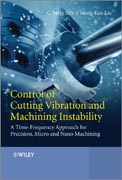
Control of Cutting Vibration and Machining Instability
Suh, C. Steve
Liu, Meng–Kun
Presents new developments on machine tool vibration control based on discontinuous dynamical systems Machining instability is a topical area, and there are a wide range of publications that cover the topic. However, many of these previous studies have started by assuming that the behavior of the system can be linearised. Meanwhile, there are many recent advances in the fields of signal processing, nonlinear dynamics, and nonlinear control, all of which are relevant to the machining stability problem. This book establishes the fundamentals of cutting mechanics and machine tool dynamics in the simultaneous time–frequency domain. The new nonlinear control theory developed by the authors that facilitates simultaneous control of vibration amplitude in the time–domain and spectral response in the frequency–domain provides the foundation for the development of a controller architecture universally viable for the control of dynamic instability including bifurcation and chaos. Once parameters underlying the coupling, interaction, and evolution of different cutting states and between the tool and workpiece are established, they can then be incorporated into the architecture to create a control methodology that mitigate machining instability and enable robust, chatter–free machine tool design applicable in particular to high speed micro– and nano–machining. Presents new developments on machine tool vibration control based on discontinuous dynamical systems Provides a clear and concise approach to the understanding and control of machine tool and workpiece vibrations from an alternative view, contributing to an in–depth understanding of cutting dynamics and robust control of machining instability Equips the reader with the knowledge to understand the dynamics of cutting and operation of machine–tool systems in different conditions as well as the concept of cutting instability control Includes data examples in MATLAB coding INDICE: Preface ix 1 Cutting Dynamics and Machining Instability 1 1.1 Instability in Turning Operation 2 1.1.1 Impact of Coupled Whirling and Tool Geometry on Machining 3 1.2 Cutting Stability 10 1.3 Margin of Stability and Instability 12 1.4 Stability in Fine Cuts 23 1.5 Concluding Remarks 31 References 32 2 Basic Physical Principles 33 2.1 Euclidean Vectors 33 2.2 Linear Spaces 34 2.3 Matrices 36 2.3.1 Eigenvalue and Linear Transformation 37 2.4 Discrete Functions 38 2.4.1 Convolution and Filter Operation 39 2.4.2 Sampling Theorem 40 2.4.3 z–Transform 41 2.5 Tools for Characterizing Dynamic Response 42 2.5.1 Fourier Analysis 49 2.5.2 Wavelet Analysis 51 References 54 3 Adaptive Filters and Filtered–x LMS Algorithm 55 3.1 Discrete–Time FIR Wiener Filter 55 3.1.1 Performance Measure 56 3.1.2 Optimization of Performance Function 58 3.2 Gradient Descent Optimization 60 3.3 Least–Mean–Square Algorithm 62 3.4 Filtered–x LMS Algorithm 64 References 68 4 Time–Frequency Analysis 71 4.1 Time and Frequency Correspondence 72 4.2 Time and Frequency Resolution 75 4.3 Uncertainty Principle 76 4.4 Short–Time Fourier Transform 77 4.5 Continuous–Time Wavelet Transform 79 4.6 Instantaneous Frequency 81 4.6.1 Fundamental Notions 82 4.6.2 Misinterpretation of Instantaneous Frequency 85 4.6.3 Decomposition of Multi–Mode Structure 90 4.6.4 Example of Instantaneous Frequency 94 4.6.5 Characteristics of Nonlinear Response 97 References 100 5 Wavelet Filter Banks 101 5.1 A Wavelet Example 101 5.2 Multiresolution Analysis 104 5.3 Discrete Wavelet Transform and Filter Banks 112 References 116 6 Temporal and Spectral Characteristics of Dynamic Instability 117 6.1 Implication of Linearization in Time–Frequency Domains 118 6.2 Route–to–Chaos in Time–Frequency Domain 125 6.3 Summary 134 References 134 7 Simultaneous Time–Frequency Control of Dynamic Instability 137 7.1 Property of Route–to–Chaos 137 7.1.1 OGY Control of Stationary and Nonstationary H´enon Map 139 7.1.2 Lyapunov–based Control of Stationary and Nonstationary Duffing Oscillator 140 7.2 Property of Chaos Control 144 7.2.1 Simultaneous Time–Frequency Control 145 7.3 Validation of Chaos Control 155 References 162 8 Time–Frequency Control ofMilling Instability and Chatter at High Speed 165 8.1 Milling Control Issues 165 8.2 High–Speed Low Immersion Milling Model 167 8.3 Route–to–Chaos and Milling Instability 168 8.4 Milling Instability Control 170 8.5 Summary 175 References 176 9 Multidimensional Time–Frequency Control of Micro–Milling Instability 177 9.1 Micro–Milling Control Issues 177 9.2 Nonlinear Micro–Milling Model 179 9.3 Multivariable Micro–Milling Instability Control 181 9.3.1 Control Strategy 183 9.4 Micro–Milling Instability Control 186 9.5 Summary 193 References 197 10 Time–Frequency Control of Friction Induced Instability 199 10.1 Issues with Friction–Induced Vibration Control 199 10.2 Continuous Rotating Disk Model 201 10.3 Dynamics of Friction–Induced Vibration 206 10.4 Friction–Induced Instability Control 208 10.5 Summary 214 References 215 11 Synchronization of Chaos in Simultaneous Time–Frequency Domain 217 11.1 Synchronization of Chaos 217 11.2 Dynamics of a Nonautonomous Chaotic System 219 11.3 Synchronization Scheme 222 11.4 Chaos Control 223 11.4.1 Scenario I 223 11.4.2 Scenario II 227 11.5 Summary 227 References 229 Appendix: MATLAB® Programming Examples of Nonlinear Time–Frequency Control 231 A.1 Friction–Induced Instability Control 231 A.1.1 Main Program 232 A.1.2 Simulink® Model 236 A.2 Synchronization of Chaos 239 A.2.1 Main Program 239 A.2.2 Simulink® Model 244 Index 245
- ISBN: 978-1-118-37182-4
- Editorial: Wiley–Blackwell
- Encuadernacion: Cartoné
- Páginas: 260
- Fecha Publicación: 24/09/2013
- Nº Volúmenes: 1
- Idioma: Inglés
